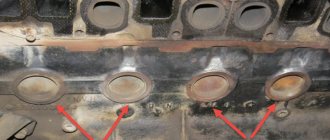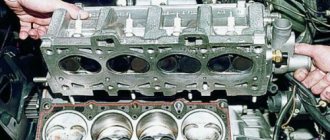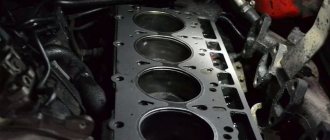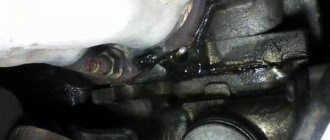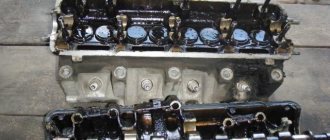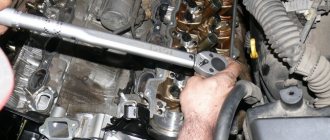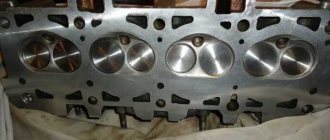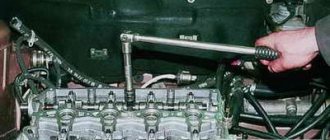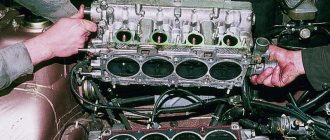Share:
Tightening torques for VAZ cylinder head 8 and 16 valves are the topic of this article. It shows the tightening torque of the cylinder head bolts of various cars. Tightening diagrams for VAZ cylinder head bolts of different models are posted. The sequence of tightening the cylinder head bolts for each VAZ engine is described. Marks of bolts connecting the cylinder head to the engine block are laid out.
The tightening torque of the VAZ cylinder head is the size of the tightening force of the fasteners of the cylinder head of a VAZ car engine, at which the threads of the hardware do not break and the body of the cylinder head does not deteriorate.
Tightening torque of cylinder head bolts VAZ 2101
Tightening the cylinder head bolts 2101-1003271 and 1/60441/30 must be done 2 times, in the order shown in the image.
The tool used is a 19mm head, a 13mm head, a collar and a rod or ratchet
Tightening torques for VAZ 2101 cylinder head bolts from 1 to 10:
- 1 time - 34 ÷ 42 N/m;
- 2 times - 100 ÷ 120 N/m.
Torque of head bolts No. 11:
- Primary moment - 14 ÷ 16 N/m;
- The final force is 32 ÷ 40 N/m.
How to use a torque wrench
To obtain the correct tightening torque, you need to understand how to use such a specific tool as a torque wrench.
Before starting work, it must be set to zero. After this, the tool is put on the bolt (or nut) and begins to rotate slowly, tracking the dynamics on the scale. When the force reaches the required torque, the key is removed.
Sometimes it happens that the tool does not show anything at first. In this case, continue rotating. The fact is that over time, its internal mechanisms stretch, but this practically does not affect the accuracy of determining the tightening torque.
Tightening torques for the cylinder head of the VAZ 2102 engine
Tightening the cylinder head fasteners must be done in 2 steps, according to the sequence indicated in the drawing below.
To tighten it, we use a 19 and 13 socket head, as well as a torque wrench.
Screwing force for cylinder head mounting from 1 to 10:
- Initial - 3.4 ÷ 4.2 kgf/m;
- Final - 10 ÷ 12 kgf/m.
Screwing force of the bolts of the head of block No. 11:
- First time - 1.4 ÷ 1.6 kgf/m;
- The second is 3.2 ÷ 4.0 kgf/m.
How to tighten correctly?
You can tighten the bolts with the help of specialists or yourself. If you have never encountered the need to perform this task before, then below we will look at how tightly you should tighten the screws and in what sequence you should do it.
Be sure to strictly observe the tightening torque, since if the head bolts are overtightened, this will lead to cracks and damage to the cylinder head. If this happens, the car owner will have to carry out major repairs to the unit. The working surface of the hole, as well as the threaded connection of the screw, must be as clean as possible. A wire brush can be used to clean the cylinders.
If during the task you find “blind” holes for the head screws, use a cleaning lubricant carefully. If the volume of the substance is greater than required, it will be difficult to install the pin all the way
It is recommended to lubricate the threads of new bolts with a small amount of engine oil or another type of lubricant.
Tools and materials
To tighten the cylinder head, prepare only one tool - a torque wrench, which will allow you to determine the tightening force of the screws. It is best to purchase a key in a specialized store or rent it at a service station, since this tool can only be used for tightening and tightening. Using a regular wrench will not allow you to determine how many kilograms the tightening force is.
When purchasing bolts, it is recommended to give preference to branded parts. Be sure to look at the threaded part - it must be intact, without damage or defects; if any, the fasteners are replaced.
Channel “Engine Repair! And interesting!” published a video that describes all the nuances of the stretching process.
Algorithm of actions
The order and strength required when pulling the cylinder head bolts is as follows:
- In accordance with the diagram below, tighten all bolts using a torque wrench. The tightening torque on the first round of tightening the fasteners will be about 3.5 - 4.1 kgf/m. First, the bolts are tightened, which are located in the center of the block head - top and bottom. After this, the two upper and lower fasteners are screwed in, installed on the side of the screws located in the center. Then the two outer bolts are tightened. Please note that you need to tighten the left pins first, and then the right ones. Screw number 11, located at the bottom left, does not need to be touched.
- This is the first stretch circle. At the second stage, the bolts are tightened in a similar order. Only the force with which the fastening elements are tensioned by the tool will be 10.5 - 11.5 kgf/m.
- At the third stage, the bolt is tensioned, which is marked with number 11 in the diagram. The tightening force of this screw should be 3.5 - 4.0 kgf/m.
Loading …
Tightening torque of cylinder head bolts VAZ 2104
Tightening the block head must be done 2 times, in sequence, according to the diagram below.
To do this, use the following tool: a head for 19 and 13, an extension and a measuring ratchet
The tightening torque of VAZ 2104 cylinder head bolts from 1 to 10 is performed in two times:
- Tighten the bolts once to a torque of 34 ÷ 42 N/m;
- Tighten the bolts once with a torque of 100 ÷ 120 N/m.
The tightening torque for cylinder head bolt No. 11 is performed in two times:
- The bolt is tightened once with a torque of 14 ÷ 16 N/m;
- tightens once with a torque of 32 ÷ 40 N/m.
General rules for performing work, methods used
There are a number of general rules that must be followed when installing the block head:
Despite the fact that each engine has its own characteristics of tightening the cylinder head, the general technology of this operation is the same. In general, two methods are used to tighten fasteners:
The tightening method is selected based on the type of bolts.
The first method is used when using non-stretching bolts (these are not used now, but they can be found on old cars). But often this type of fasteners requires tightening after a certain period of engine operation in order to compensate for the shrinkage of the cylinder head gasket. But such fasteners are allowed for reuse, and more than once.
The second method of tightening the block is relevant for most modern cars. And all due to the use of tensile bolts (the so-called TTY type).
Such fasteners, due to elastic deformation, are able to compensate for thermal expansion of the head and shrinkage of the gasket, but for this they need to be put into deformation mode (in fact, just stretched a little).
To do this, it is necessary to tighten the bolts twice to a certain angle. On some cars this angle is 45 degrees, on others it is 90 degrees.
But after the elements are put into elastic deformation mode, they will no longer be able to return to their original state, and therefore their reuse is not allowed due to the high probability of destruction.
Tightening torques for cylinder head of VAZ 2106 and VAZ 2121
The block head bolts are tightened in 2 approaches, according to the diagram shown below.
To do this, we use a head for 19 and 13, as well as a torque wrench
| Engine model | Cylinder head bolt number | Tightening torques for VAZ cylinder head bolts, N/m | |
| Elementary | Final | ||
| VAZ 2106 | from 1 to 10 | 34 ÷ 4,2 | 10 ÷ 12 |
| 11 | 14 ÷ 16 | 32 ÷ 40 | |
| VAZ 2121 | from 1 to 10 | 34 ÷ 4,2 | 10 ÷ 12 |
| 11 | 14 ÷ 16 | 32 ÷ 40 | |
When is it necessary to puff?
First, let's look at the cases in which it is necessary to tighten the bolts of the cylinder head of a VAZ 2106 car engine:
- If engine oil comes out from under the cylinder head. The problem indicates damage or natural wear to the head gasket. It is necessary to remove and replace the seal. The leak may also be due to loose cylinder head bolts. The presence of a problem is indicated by oil stains that appear at the junction of the head and the motor block.
- After repairing the power unit. If you removed the fastenings in a Niva or any other car and rebuilt the engine, then for successful assembly you should take into account the order of tightening and the diagram, as well as the tightening force of the screws.
- For prevention purposes. Experts recommend tightening the bolts on the cylinder head every 2-3 thousand kilometers. When the engine is operated under vibration conditions, this can cause the screws to loosen, so they must be periodically checked and tightened with proper force.
The Ilyich Garage channel has published a video that will help you understand the process of tightening the cylinder head bolts on the “six”.
Tightening torques for the cylinder head of VAZ 21073, 21213, 21214, 21214-10
Tightening bolts with 1 ÷ 10, models 21213-1003271 and 1/60441/30 is performed in 4 approaches in the order shown in the picture.
The tool used is a 12mm head, a 13mm head, a curved drap and an extension or ratchet.
| Engine model | Cylinder head bolt number | Tightening torque of VAZ cylinder head bolts, N/m | |||
| Elementary | Second time | Third time | Final | ||
| VAZ 21073 | from 1 to 10 | 12 ÷ 20 | 50 ÷ 70 | rotates 90o ÷ 110o | rotates 90o ÷ 110o |
| 11 | 14 ÷ 16 | 32 ÷ 40 | — | — | |
| VAZ 21213 | from 1 to 10 | 12 ÷ 20 | 50 ÷ 70 | rotates 90o ÷ 110o | rotates 90o ÷ 110o |
| 11 | 14 ÷ 16 | 32 ÷ 40 | — | — | |
| VAZ 21214 | from 1 to 10 | 12 ÷ 20 | 50 ÷ 70 | rotates 90o ÷ 110o | rotates 90o ÷ 110o |
| 11 | 14 ÷ 16 | 32 ÷ 40 | — | — | |
| VAZ 21214-10 | from 1 to 10 | 12 ÷ 20 | 50 ÷ 70 | rotates 90o ÷ 110o | rotates 90o ÷ 110o |
| 11 | 14 ÷ 16 | 32 ÷ 40 | — | — | |
Healthy ! Tightening torques for VAZ 2107
A set of tools required for work
In order to avoid wasting time looking for this or that tool at the critical moments of replacing the gasket on a VAZ (or actually tightening it), it is better to prepare everything in advance.
You will definitely need:
- wrench with heads and extension;
- Screwdriver Set;
- torque wrench;
- new gasket;
- sealant.
It is better to park the car on a level surface, turn on the handbrake, and additionally secure it with stops.
Tightening torques for the head of the VAZ 2109 block
The cylinder head bolts must be tightened in four steps, in the sequence shown in the diagram below
Mount the cylinder head on the block. Before doing this, check that the crankshaft and camshaft are located at TDC (all valves of the 1st pot must be closed). Tighten the head bolts in the following order, in 4 steps:
| 1 | moment 2 kgf-m; |
| 2 | moment 7.1 - 8.7 kgf-m; |
| 3 | turn 90o; |
| 4 | tighten 90o. |
Lada 2103 “Ryzhik” › Logbook › Engine. Part 6. Pre-assembly of the cylinder head and measurements.
In the previous part, we selected the cylinder head parts of our Ryzhik and prepared everything for its initial assembly. The point is that while the block head is sitting on the slipway, we need to make sure that all the desired parameters are met, and it can be safely placed on the block.
Here's what interests us first: 1. Measure the height of the springs in the dried state and in the most compressed state, and align them in height. 2. Determine the TDC mark of the camshaft. 3. Grinding in valves and checking tightness.
To perform all these checks and measurements, we may need to dry out and de-dry the valves frequently. A conventional “yoke” desiccant is completely inconvenient for a slipway, because you need to constantly support the valve from below. Therefore, we decided to creatively “rework” it with a grinder and welding:
We welded a “foot” that will hold the valve from below, and built a homemade “bearing” from an old valve guide. Plus studs, nuts, washers - they were done quickly and roughly, but you can use them:
The lower part of our desiccant is wrapped with electrical tape so as not to accidentally scratch the polished surface of the cylinder head. However, the “heel” supporting the valve should have been made a little larger to make it easier to hold the instrument when drying...
*** Measuring the height of the springs
***
So, using our old-new tool, we dry out the valves and measure the height of all springs with a caliper depth gauge - from washer to washer:
We get the following values in mm: (1)—-(2)—-(3)—-(4)—-(5)—-(6)—-(7)—-(8) 34.1 34.6 35.6 34.0 34.9 34.5 34.5 34.3
As you can see, there is a decent spread of values: from 34.0 to 35.6, which gives a difference in effort of up to 4 kg! At the same time, for a stock engine, the recommended height of the dried springs should be 33.7-34.0 mm (this is especially important at the exhaust), which corresponds to a force of approximately 42 kgG. Let's estimate the required force for our 44th OKB Engine camshaft. We proceed from the fact that on standard springs 2101 the height of the spring before the coils close is 23.0 mm - i.e. There is 1.5 mm between the turns. We add valve lift 11.6, and we get a dry height of 34.6 mm, which corresponds to a force of 40 kg. This force is 2 kg less than recommended for stock (42 kgf), but quite enough for us, given the lightweight valves and plates. All that remains is to equalize the heights of our springs to a value of 34.6. First, we will use a rough method: we place additional adjusting washers 0.5 mm thick under the springs, where necessary, in order to achieve the height of all springs no more than the desired value. Then you need to gradually widen the tapered hole for the crackers in the valve plates to ensure the same “fit” for all 8 springs. Our duralumin plates already have an initial “dissolution”, corresponding to about 1 mm of the height of the springs, and we only need to correct it a little. There are special cone reamers for this, but we will try to use the “folk” method. True, it is important to take into account several points: 1) widening the conical hole for the crackers by only 0.3 mm increases the height of the spring by almost 2 mm! Great precision and accuracy are required. 2) the crackers must not be riveted (preferably new).
Tightening torque for cylinder head VAZ 2108 - 21083, 2110, 2111
Tightening the cylinder head bolts of VAZ 2108 - 21083, 2110, 2111 is performed 4 times in the order shown in the image
For screwing, the following tool is used: adapter 67.7812-9543 for bolts of brand 2108-1003271, wrench TL-98-110 with parameters E14 for bolts of brand 2108-1003271-01, bend and extension or power tool of brand IP - 3111.
The tightening torque of the cylinder head bolts of the VAZ 2108 - 21083 is carried out in 4 steps:
- once we tighten the bolts to a torque of 18 - 22 N/m (1.8 - 2.2 kgf/m);
- Tighten the bolts once to a torque of 70 - 85 N/m (7.0 - 8.5 kgf/m);
- turn it 90° once;
- Once again, turn the bolts 90°.
| Engine model | Cylinder head bolt number | Tightening torque of VAZ cylinder head bolts, N/m | |||
| Elementary | Second time | Third time | Final | ||
| VAZ 2110 | from 1 to 10 | 18 ÷ 22 | 70 ÷ 85 | turn it 90o | turn 90o |
| VAZ 2111 | from 1 to 10 | 18 ÷ 22 | 70 ÷ 85 | turn it 90o | turn 90o |
Healthy ! Tightening torques for VAZ 2108
Basic recommendations
First of all, it should be noted that such a procedure can be carried out after repairing the power unit or in order to check the tightening torque of the bolts during engine operation. If the cylinder head has been dismantled, you should carefully inspect the bolts, as well as the holes in the cylinder block for their installation. Screws must not have elongation or deformation of the threaded part. The holes in the block for the bolts are cleaned of any remaining engine oil, liquid, or other foreign particles. If this is not done, the cylinder block may be damaged, and the cylinder head will not be able to be tightened with the required force.
This is interesting: Causes of valve knocking on a cold engine and how to eliminate them
Work should begin only after reading the vehicle manufacturers' recommendations for operation and repair. There the driver will find all the necessary information to complete the job, including the forces and sequence of tightening the bolts.
Another feature of using such bolts is their installation at a certain angle. To do this, you will need a special key with an indicator that will show the degree of inclination.
User Igor Ivanov shows in the video the installation and tightening of the cylinder head.
Bolt tightening torque (force)
The tightening torque for the bolts is different for each car (due to design features). Each vehicle has its own table of fastener tightening torques. In the next section, we will consider the cylinder head fastening forces using the example of a VAZ head.
Table: tightening torques for connections depending on thread diameter
| Nominal thread diameter | Turnkey size of head, bolt (nut), mm | Thread pitch, mm | Strength classes according to GOST 1759–70 | ||||
| Bolt | |||||||
| 5.8 | 6.8 | 8.8 | 10.9 | 12.9 | |||
| screw | |||||||
| 6 | 10 | 1 | 0,5 | 0,8 | 1,0 | 1,25 | 1,6 |
| 8 | 12 — 14 | 1,25 | 1,6 | 1,8 | 2,5 | 3,6 | 4,0 |
| 10 | 14 — 17 | 1,25 | 3,2 | 3,6 | 5,6 | 7,0 | 9,0 |
| 12 | 17 — 19 | 1,25 | 5,6 | 6,2 | 10,0 | 12,5 | 16,0 |
| 14 | 19 — 22 | 1.5 | 8,0 | 10,0 | 16,0 | 20,0 | 25,0 |
| 16 | 22 — 24 | 1,5 | 11,0 | 14,0 | 22,0 | 32,0 | 36,0 |
| 18 | 24 — 27 | 1,5 | 16,0 | 20,0 | 32,0 | 44,0 | 50,0 |
| 20 | 27 — 30 | 1,5 | 22,0 | 28,0 | 50,0 | 62,0 | 70,0 |
| 22 | 30 — 32 | 1,5 | 28,0 | 36,0 | 62,0 | 80,0 | 90,0 |
| 24 | 32 — 36 | 1,5 | 36,0 | 44,0 | 80,0 | 100,0 | — |
Correct tightening order
There is a certain order for tightening the bolts; it is the same on almost all cars - from the center of the head to its edges, cross to cross. So, for example, the two central bolts of the right and left rows are tightened first, then the two bolts located to the left of the central ones, then the two to the right of the central ones, then the two bolts located on the left in both rows, and the bolts located on the right in both rows complete the order.
It is important to remember that fastening is always performed in three to four approaches:
- The first approach is a force of 3-4 kgf.
- The second approach is a force of 7 kgf.
- The third approach is a force of 9 kgf.
- The last approach is a force of 11.5 - 12 kgf.
Some nuances
The tightening torque is one of the main factors for the normal fit of the block head. But this criterion is influenced not only by the applied force, but also by the fasteners themselves:
- General condition of the bolts – new or used;
- Presence of lubricant on the threaded part;
- Thread condition.
The type of power plant (petrol, diesel), as well as the number of valves, does not affect the cylinder head tightening technology. But this does not mean that the force and tightening procedure are identical for all motors, and before seating the head, you should definitely study the conditions for performing the operation and all its features.
Errors when installing the head
If you do not use a torque wrench when installing the cylinder head, you may make a mistake with the force, which will lead to uneven torque. In such cases, there will be excessive or insufficient force, which will result in either deformation of the head surface or allow the breakthrough of gases, oil or coolant. In both cases, this is fraught with serious consequences for the engine.
If you follow the rules for tightening the fastening bolts, as well as the required torque, you can always count on reliable and durable operation of the installed parts. The gas distribution mechanism in the engine plays a major role, so you should not neglect the rules for installing the component elements.
Tightening torques for VAZ 2112 cylinder head
Tighten the bolts three times in the order shown in the image
To tighten the bolts, you must use adapter 67.7812-9543, a gate and a rod or a power tool model IP - 3111..
The tightening torque for the cylinder head bolts is:
- First time - 18 ÷ 22 N.m (1.8 ÷ 2.2 kgf.m);
- The second time - turn it 90°;
- The third time - twist it 90°.
Healthy ! Tightening torques for VAZ 2112
Tightening torques for the head of the block VAZ 2113, 2114, 2115
Tighten the bolts in four steps, in the order shown in the image
To tighten the bolts, you must use a Torx E14 socket wrench.
Warnings! Reuse of cylinder head bolts is only permitted if their length does not exceed 135.5 mm
Using a caliper or a mechanic's ruler, measure the length of the bolts.
Important ! Bolts longer than 135.5 mm are replaced.
Tighten the M12XI.25 cylinder head mounting bolts 4 times:
- Initial force - 2 kgf/m;
- Second time - 7 ÷ 8.6 kgf/m;
- Third time - turn it 90°;
- The fourth time - tighten the bolts 90°.
The remaining tightening torques for bolts and nuts of all threaded connections of VAZ 2113, 2114, 2115 vehicles can be found here
Article: 2101-1003265
Order code: 013316
- You may need
- show more
- Passenger cars / VAZ / VAZ-21021 drawing
- » href=»/catalog/vaz-3/legkovye_avtomobili-30/vaz_2102-4/blok_cilindrov_i_golovka_bloka-77/#part6277″>Washer 12Engine / Cylinder block and cylinder head
- Passenger cars / VAZ / VAZ-21042 drawings
- » href=»/catalog/vaz-3/legkovye_avtomobili-30/vaz_2104-5/blok_cilindrov_i_golovka_bloka-54/#part13471″>Washer 12Engine / Cylinder block and cylinder head
- » href=»/catalog/vaz-3/legkovye_avtomobili-30/vaz_2104-5/blok_cilindrov_i_golovka_bloka-55/#part13495″>Washer 12Engine / Cylinder block and cylinder head
- Passenger cars / VAZ / VAZ-21061 drawing
- » href=»/catalog/vaz-3/legkovye_avtomobili-30/vaz_2106-7/blok_cilindrov_i_golovka_bloka-57/#part19715″>Washer 12 Engine assembly / Cylinder block and cylinder head
- Passenger cars / VAZ / VAZ-21211 drawing
- » href=»/catalog/vaz-3/legkovye_avtomobili-30/vaz_2121-13/blok_cilindrov_i_golovka_bloka-46/#part58453″>Washer 12Engine / Cylinder block and cylinder head
- Passenger cars / AZLK / Moskvich-21411 drawing
- » href=»/catalog/azlk-9/legkovye_avtomobili-30/moskvich_2141-53/blok_cilindrov_i_golovka_bloka-59/#part148625″>Washer 12Engine mod. 2106 / Cylinder block and head
- Passenger cars / IZH / IZH 2126 with VAZ1 engine drawing
- » href=»/catalog/ij-7/legkovye_avtomobili-30/ij_2126_s_dvigatelem_vaz-307/blok_cilindrov_i_golovka_bloka-9/#part945826″>WasherEngine / Cylinder block and cylinder head
- Passenger cars / IZH / IZH 27171 drawing
- » href=»/catalog/ij-7/legkovye_avtomobili-30/ij_2717-607/blok_cilindrov_i_golovka_bloka-33/#part1693573″>Washer VAZ-2106 engine / Cylinder block and cylinder head
- Passenger cars / VAZ / VAZ-21011 drawing
- » href=»/catalog/vaz-3/legkovye_avtomobili-30/vaz_2101-3/blok_cilindrov_i_golovka_bloka-77/#part1793″>Washer 12Engine / Cylinder block and cylinder head
- Passenger cars / VAZ / VAZ-21031 drawing
- » href=»/catalog/vaz-3/legkovye_avtomobili-30/vaz_2103-106/blok_cilindrov_i_golovka_bloka-52/#part10144″>Washer 12Engine / Cylinder block and cylinder head
- Passenger cars / VAZ / VAZ-21052 drawings
- » href=»/catalog/vaz-3/legkovye_avtomobili-30/vaz_2105-6/blok_cilindrov_i_golovka_bloka-54/#part16577″>Washer 12Engine / Cylinder block and cylinder head
- » href=»/catalog/vaz-3/legkovye_avtomobili-30/vaz_2105-6/blok_cilindrov_i_golovka_bloka-55/#part16601″>Washer 12Engine / Cylinder block and cylinder head
- Passenger cars / VAZ / VAZ-21072 drawings
- » href=»/catalog/vaz-3/legkovye_avtomobili-30/vaz_2107-8/blok_cilindrov_i_golovka_bloka-59/#part23085″>Washer 12Engine / Cylinder block and cylinder head
- » href=»/catalog/vaz-3/legkovye_avtomobili-30/vaz_2107-8/golovka_bloka-58/#part23056″>Washer 12Engine / Block head
- Passenger cars / VAZ / VAZ-212131 drawing
- » href=»/catalog/vaz-3/legkovye_avtomobili-30/vaz_21213-731/golovka_bloka-51/#part2008903″>Washer 12Engine / Block head
- Passenger cars / AZLK / Moskvich-23351 drawing
- » href=»/catalog/azlk-9/legkovye_avtomobili-30/moskvich_2335-688/blok_cilindrov_i_golovka_bloka-6/#part1902846″>Washer 12Engine / Cylinder block and cylinder head
- Passenger cars / IZH / IZH 21261 drawing
- » href=»/catalog/ij-7/legkovye_avtomobili-30/ij_2126-606/blok_cilindrov_i_golovka_bloka-35/#part1690459″>Washer VAZ-2106 Engine / Cylinder block and cylinder head There are no reviews for this product yet.
Today, the next article in the series “Crystal VAZs or typical breakdowns of domestic cars” is dedicated to the “classics”: VAZ-2101, 2103, 2104, 2104, 2105, 2106 and 2107. These cars have been driving along our roads for decades and, despite Despite all the shortcomings that we will talk about, their popularity is still high.
Tightening torques for VAZ 21114 cylinder head
Tighten the cylinder head bolts in four steps according to the diagram shown below in the figure:
To tighten the bolts, you must use an adapter type 02 15 12 10 f. "Stahlwille", 234 N 10L f. "USAG", IN 30L10 f. "GEDORE", S09H410 f. “JONNESWAY” for hardware 2108-1003271, replaceable head 14, wrench TL-98-110 size E14 for bolts 2108-1003271-01, wrench and extension or impact wrench type IP - 3111, torque wrench.
The tightening torque for the cylinder head bolts is:
- First reception - 18 ÷ 22 N.m (1.8 ÷ 2.2 kgf.m);
- Second reception - 70 ÷ 85 N.m (7.0 ÷ 8.5 kgf.m);
- The third step is to turn it 90°;
- The fourth technique is to twist it 90°.
Part Features
The cylinder head is a structurally quite complex part. It is a massive plate in which there are channels for the circulation of fluids of the lubrication and cooling system, and technological holes - spark plugs, for injectors (in diesel engines), mounting holes.
Also on top of the cylinder head there is a so-called “bed” of the camshaft - a seat for its installation.
Despite its massiveness, the block head is a fragile part due to the voids inside, so excessive tightening force often leads to cracks in the walls and bridges.
For the manufacture of cylinder head, two types of metals are used - aluminum (the most common) and cast iron.
To secure the latter, steel bolts or studs with nuts are used. For example, the head of the UAZ 31519 block is secured with studs.
The difference in the materials used to make the head and its fasteners has one negative factor - different thermal expansion of the components when heated, especially for aluminum cylinder heads.
Uneven tightening of fasteners (nuts, studs, etc.) during thermal expansion leads to the appearance of excessive stress in the metal structure, resulting in warping of the head.
Tightening torques for the cylinder head of the VAZ 11183 engine
Tighten the cylinder head hardware four times according to the drawing shown below:
To tighten the bolts you need to use an adapter type 02 15, 12 10 f. "Stahlwille", 234 N 10L f. "USAG", IN 30L10 f. "GEDORE", S09H410 f. “JONNESWAY” for dowels 2108-1003271, replaceable head 14, key TL-98-110 sizes E14. For bolts 2108-1003271-01 - gate and rod or wrench type IP - 3111, torque wrench.
The tightening torques for the block head bolts have the following parameters:
- 1 time - 18 ÷ 22 N.m (1.8 ÷ 2.2 kgf.m);
- 2 times - 70 ÷ 85 N.m (7.0 ÷ 8.5 kgf.m);
- 3 times - turn 90°;
- 4 times - turn it 90°.
Tightening torques for the cylinder head of the VAZ 21124 engine
Tighten the bolts in 4 stages in the order shown in the figure below:
To tighten the bolts, use the following tools: adapter type 02 15 12 10 lb. "Stahlwille", 234 N 10L ph. "USAG", IN 30L 10 lbs. “GEDORE”, S09H410 f. “JONNESWAY” for bolts 2112-1003271, replaceable head 14, wrench TL 98-110 size E14 for bolts 2112-1003271-01, wrench and extension or wrench type IP-3111, torque wrench ..
The tightening torque of the cylinder head bolts is:
- Stage 1 - 12 ÷ 20 N.m (1.2 ÷ 2.0 kgf.m);
- Stage 2 - 26 ÷ 34 N.m (2.6 ÷ 3.4 kgf.m);
- Stage 3 - turn by 90°;
- Stage 4 - turn by 90°.
Tightening torques for the head of the VAZ 21126, 11194 engine block
Twist the hardware 4 times in the sequence shown below in the image:
For screwing, you must use the following tool: adapter 67.7812-9543 for bolts model 2108-1003271, wrench TL-98-110 with size E14 for bolts brand 2108-1003271-01, bend and rod or power tool model IP - 3111.
| Engine model | Cylinder head bolt number | Tightening torque of VAZ cylinder head, N/m | |||
| 1 time | 2 times | 3 times | 4 times | ||
| VAZ 21126 | from 1 to 10 | 12 ÷ 20 | 26 ÷ 34 | turn it 90o | turn 90o |
| VAZ 11194 | from 1 to 10 | 12 ÷ 20 | 26 ÷ 34 | turn it 90o | turn 90o |
Camshaft VAZ 2107
The camshaft is the main element of the gas distribution mechanism of a car engine. This is an all-metal part, made in the form of a cylinder with support journals and cams placed on it.
The camshaft contains cams and journals
Purpose
The timing shaft is used to control the processes of opening and closing valves in the combustion chambers of the engine. In other words, it synchronizes the operating strokes of the power unit, promptly admitting the fuel-air mixture into the combustion chambers and releasing exhaust gases from them. The camshaft of the “seven” is driven by the rotation of its star (gear), connected through a chain to the crankshaft gear.
Where is it located?
Depending on the design of the engine, the timing shaft may have a different location: upper and lower. With its lower location, it is installed directly in the cylinder block, and with its upper location, it is installed in the cylinder head. For "sevens" the camshaft is located in the upper part of the cylinder head. This arrangement, first of all, makes it easily accessible for repair or replacement, as well as for adjusting valve clearances. In order to get to the timing shaft, just remove the valve cover.
Operating principle
As mentioned, the camshaft is driven by the crankshaft gear. At the same time, its rotation speed, due to the different sizes of the drive gears, is reduced exactly by half. The full operating cycle of the engine occurs in two revolutions of the crankshaft, but the timing shaft makes only one revolution, during which it manages to let the fuel-air mixture into the cylinders one by one and release the exhaust gases.
The opening (closing) of the corresponding valves is ensured by the action of the cams on the valve tappets. It looks something like this. When the shaft rotates, the cam with its protruding side presses the pusher, which transmits force to the spring-loaded valve. The latter opens a window for the intake of the combustible mixture (exhaust of gases). As the cam rotates further, the valve closes under the action of a spring.
The valves open when the protruding parts of the cams press on them
